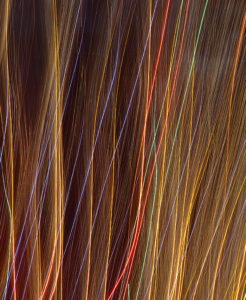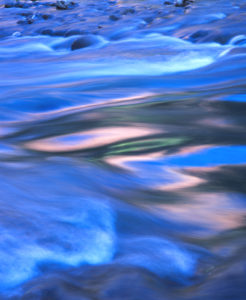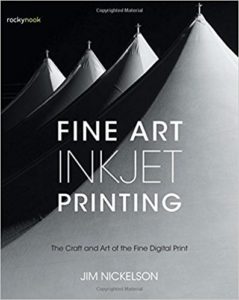Fine Art Inkjet Printing
By Jim Nickelson–
I’m often asked from friends, family, and even other photographers about why I bother printing my work when the whole world seems to be moving digital. For me, the reason is simple: creating a fine art print is my primary purpose in making photographs.

Moon When Eyes Are Sore From Bright Snow © Jim Nickelson
As is likely becoming obvious, I am a strong proponent and champion of the fine print. If you are a photographer, I think it is essential to eventually print your work.
You can do it yourself or have someone else do it, you can create a fine digital print or something equally and differently wondrous like a silver gelatin or platinum print, and you can print at whatever size that makes you happy.
The exercise of selecting a photograph for print, performing any necessary preparation, and seeing how it actually looks once off the screen can be extremely valuable.
While I love how the Internet has made it possible to disseminate images electronically, I do believe that there is something special about an actual physical print. Perhaps it is the presence of a fine print as an object.

Megunticook Morning © Jim Nickelson
Perhaps it is the implication that you care enough about the photograph to actually create a physical print, or perhaps it is the fact that so many photographs just look different (some better, some worse) on paper rather than on a backlit LCD monitor or iPad screen. Whatever the reason, I find that nothing in the world of photography compares with seeing a wonderful print of a photograph.
Making a print of your photograph, and putting care into doing so, is putting a stake in the sand for your artwork, a way of saying “this is important” and “this is what I’m trying to say.”
Printing your work has numerous advantages over a digital-only existence for your photographs, such as:
- Creating a final art object that can be displayed, shared, or sold. You can also create exclusivity by limiting how many prints you make of a particular image. For the fine art gallery world, physical prints are still a necessity.
- For many, a photograph is not a completed work of art until it is embodied in a physical print.
- Owning a physical object that provides security in case of loss of digital files without having to worry about backing up, file formats, and migrating to new media.
- This is vital also for any considering your legacy. Physical prints and portfolios are much more likely to be saved and treasured, held or donated to collections, or sold to collectors than digital files.

Illuminations #68 © Jim Nickelson
- Facilitating more careful study of the image by being firmly fixed in a physical object and also by providing more detail and substance. Digital images are often viewed very quickly, and a physical print is more often enjoyed at leisure.
- Allowing the artist to more precisely control the final look and feel of the their work without having to worry about what phone the viewer is using or whether their display is too bright or not calibrated. You can choose the precise paper that best matches your artistic intent. Printing gives you control over scale and lets you present your work large, two things that are almost impossible to accomplish with digital display with current technology.
- A carefully displayed print, with great presentation and lighting, can be a much more significant and powerful experience than viewing the same image digitally. A fine print can be almost sensual and careful viewing of a physical print is more likely to evoke an emotional response in viewers.
- Prints subjectively look better. A backlit display has drama, but a print is more beautiful. Subtlety is much easier to achieve than in print than in a digital image.

Virgin River, Reflection © Jim Nickelson
- Learning to print your photographs, spending more time with them during editing, and learning what works best (and what doesn’t work at all), will make you a better photographer as you internalize these lessons.
- Deciding what to print will help you learn to edit your photographs, something I find to be among the most difficult and elusive of skills for all of us creating photographs.
- Some photographs work far better in print than they do on the screen, and you won’t know this about a particular photograph until you try.
- Zigging when everybody else is zagging. There are millions of photographers out there seeking attention on digital platforms, and one way of distinguishing yourself from the others is to create fine prints of your photographs.
ACKNOWLEDGEMENT
 Jim Nickelson is a photographer, master printer and educator whose work resides in museum, public, corporate, and private collections across the United States and Canada. This excerpt from his new book “Fine Art Inkjet Printing, The Craft and Art of the Fine Digital Print” © 2017, has been reprinted by permission of the publisher, Rocky Nook, Inc. It is currently available from Amazon (about $30,00) and from the publisher as well as other booksellers. If purchasing from Rocky Nook use the code FINE40 for a 40% discount for Red River Paper Blog readers. The book’s Table of Contents and first three chapters are displayed at the Amazon site.
Jim Nickelson is a photographer, master printer and educator whose work resides in museum, public, corporate, and private collections across the United States and Canada. This excerpt from his new book “Fine Art Inkjet Printing, The Craft and Art of the Fine Digital Print” © 2017, has been reprinted by permission of the publisher, Rocky Nook, Inc. It is currently available from Amazon (about $30,00) and from the publisher as well as other booksellers. If purchasing from Rocky Nook use the code FINE40 for a 40% discount for Red River Paper Blog readers. The book’s Table of Contents and first three chapters are displayed at the Amazon site.
VISIT JIM’ NIKELSON’S WEBSITE HERE
Learn about Red River Paper’s line of Fine Art Printing Papers used by some of the world’s finest photographers and master printers.
Original Publication Date: October 30, 2017
Article Last updated: October 30, 2017
Comments are closed.
Categories
About Photographers
Announcements
Back to Basics
Books and Videos
Cards and Calendars
Commentary
Contests
Displaying Images
Editing for Print
Events
Favorite Photo Locations
Featured Software
Free Stuff
Handy Hardware
How-To-Do-It
Imaging
Inks and Papers
Marketing Images
Monitors
Odds and Ends
Photo Gear and Services
Photo History
Photography
Printer Reviews
Printing
Printing Project Ideas
Red River Paper
Red River Paper Pro
RRP Newsletters
RRP Products
Scanners and Scanning
Success on Paper
Techniques
Techniques
Tips and Tricks
Webinars
Words from the Web
Workshops and Exhibits
all
Archives
March, 2024
February, 2024
January, 2024
December, 2023
November, 2023
October, 2023
September, 2023
August, 2023
May, 2023
more archive dates
archive article list







